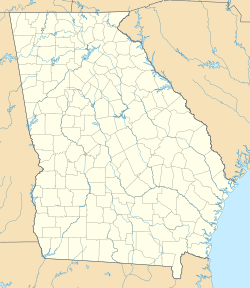Washington Park, Atlanta facts for kids
Quick facts for kids |
|
|
Washington Park Historic District
|
|
| Location | Jct. of Martin Luther King, Jr. Dr. and Ashby St., Atlanta, Georgia |
|---|---|
| Built | 1919 |
| Architectural style | Late 19th And 20th Century Revivals, Bungalow/Craftsman |
| NRHP reference No. | 00000071 |
| Added to NRHP | February 28, 2000 |
Washington Park is a special neighborhood in northwest Atlanta, Georgia. It is known for its historic homes, shops, and important community buildings. This area is about two miles (3 km) west of downtown Atlanta.
The neighborhood has a mix of straight and curvy streets. This is because it grew from four different building plans. One of these plans created Atlanta's first neighborhood designed for African Americans. Three other plans were started by white developers but later taken over by Heman Perry. Perry was an important African American developer in the early 1900s. Even though he only went to school until seventh grade, he started a very large Black-owned company in 1913 called Standard Life Insurance Company of Atlanta.
Contents
A Neighborhood's Story
The history of Washington Park is linked to how neighborhoods were separated in Atlanta long ago. Before 1919, Ashby Street was like a dividing line in the city. The area east of Ashby Street was for African Americans. The area west was for white families.
However, not many white families wanted to live so close to the historically Black Atlanta University campus. Plans for white homes west of Ashby Street changed in 1919. That year, the Parks Department of Atlanta decided to make Washington Park the first park for African Americans. Also, the Atlanta Board of Education changed Ashby Street School from a white school to a Black school. Because of these changes, white developers stopped building west of Ashby Street. This helped break down the old dividing line.
Homes and Buildings in Washington Park
The homes in Washington Park are mostly one or two stories tall. They were built between 1919 and 1958. Many have wood siding or brick on the outside. These homes are close together and set back a bit from the street on narrow lots.
You can see different types of homes here, like English and Georgian cottages. There are also American Foursquare homes and bungalows. Bungalows are the most common type you will find. The styles include Colonial Revival, English Vernacular, and Craftsman, which is also very popular.
There were not many shops in Washington Park in the past. They were usually found at the edges of the neighborhood where big streets met. Many of these old stores are now gone or have changed a lot. One old gas station from around 1930 is still there. It has an office building with a cover over the gas pumps. There is also a corner store with a big front window facing the street.
Important community buildings include the William A. Harris Memorial Hospital and the Ashby Street Theater. The Citizen Trust Company West Side Branch bank building and the E.R. Carter Elementary School (which used to be Ashby Street School) are also landmarks.
Washington Park: A Community Hub
The park itself is a very important part of this historic area. Before Washington Park was built in 1919, there were no parks in Atlanta for African Americans to use. The park started with a gift of six and a half acres. It grew to 25 acres (101,171 m2) when it was finished in 1928.
When it first opened, the park had a swimming pool, a dance hall, pavilions, and tennis courts. Many of the park's original features are still there. However, some parts of the historic area have changed. This is due to new transportation projects and modern housing developments.
Getting Around Washington Park
The neighborhood has good ways to get around. It is served by PATH's "West Side Trail." The Beltline will also connect to the park. Plus, you can easily get to the Ashby MARTA rail station.
This article uses information from the National Park Service website. This is a U.S. government work, so it is available for public use.




